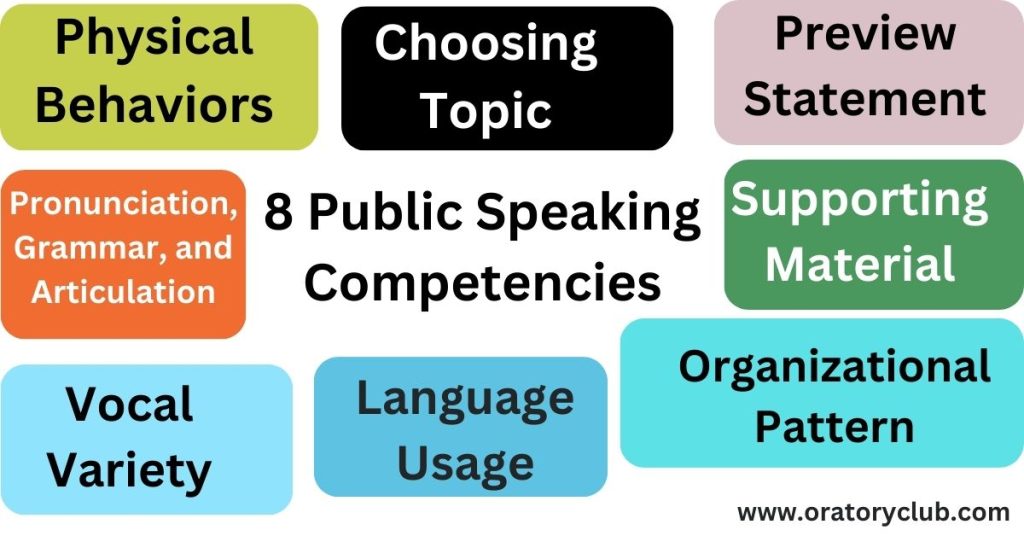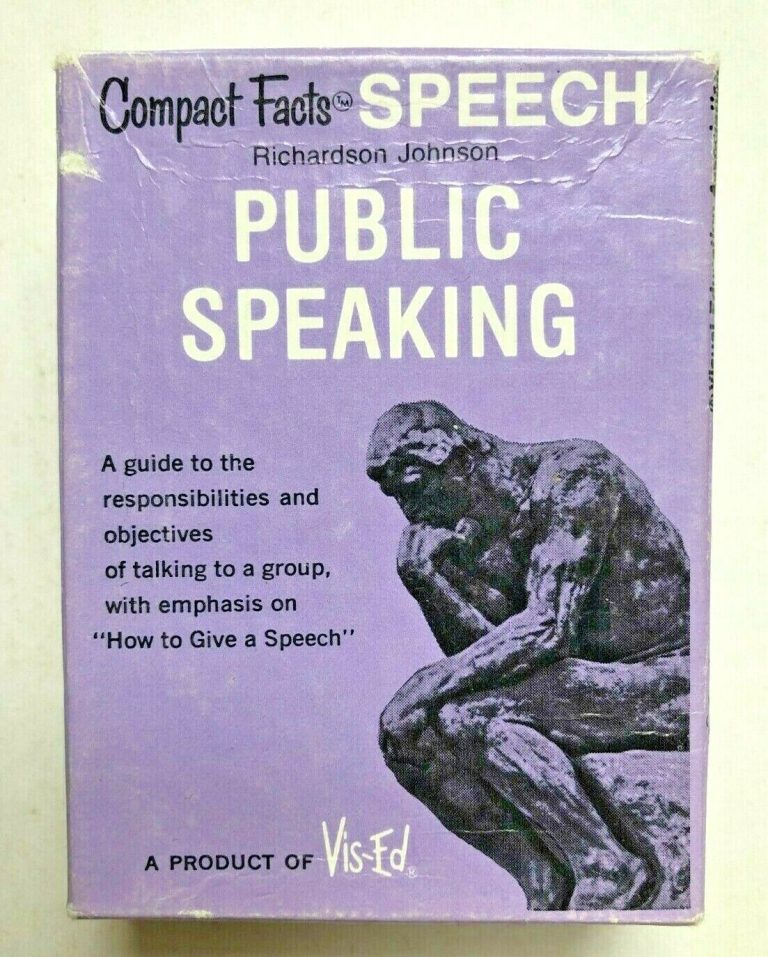8 Public Speaking Competencies by NCA You Need to Know
Public speaking is a vital skill in both professional and personal life. Whether you’re delivering a presentation at work, pitching an idea to investors, or even speaking at a social event, effective communication can make or break your message. To help you excel in the world of public speaking, we’ll explore the eight public speaking competencies suggested by the National Communication Association (NCA). These competencies encompass various aspects of delivering a powerful and persuasive speech. Let’s dive into each of them to understand their significance and how to apply them to your speaking endeavors.
Public speaking competency
Public speaking competency refers to the comprehensive set of skills and abilities required to effectively communicate and engage with an audience during a speech or presentation. It encompasses a range of essential elements, including selecting an appropriate topic, crafting a clear thesis, providing relevant supporting material, organizing content logically, using language suitable for the audience, employing vocal variety for engagement, maintaining proper pronunciation and grammar, and utilizing nonverbal behaviors that reinforce the verbal message.
Developing these competencies empowers individuals to deliver compelling and influential speeches, fostering better communication, persuasion, and engagement with listeners, whether in academic, professional, or public settings. Public speaking competency is a fundamental skill for effective communication and leadership.
8 Public Speaking Competencies Suggested by NCA
Competency 1: Choosing a Topic
Public speaking success begins with selecting the right topic. Choosing a suitable topic is not a trivial matter; it’s the foundation upon which your entire speech will be built. Here, we’ll delve into the significance of topic selection and provide practical guidelines for making the best choice.
A. The Significance of Topic Selection
Selecting the right topic is akin to finding the perfect canvas for a painting. It’s the initial step in creating a compelling and engaging speech. Here’s why it’s so crucial:
- Audience Engagement: Your audience’s interest largely depends on the topic. A well-chosen topic captivates their attention from the start and keeps them engaged throughout your speech.
- Relevance: Your topic should be relevant to your audience and the occasion. Tailoring your speech to your audience’s interests and needs makes it more impactful.
- Passion: Speaking about a topic you’re passionate about will make you a more enthusiastic and persuasive speaker. Your passion will be contagious and inspire your audience.
- Clarity: A clear and well-defined topic helps you stay focused and prevents you from going off on tangents during your speech.

B. Guidelines for Choosing a Topic
When selecting a topic, consider the following guidelines:
- Audience Analysis: Understand your audience’s demographics, interests, and knowledge level. Choose a topic that resonates with them and provides value.
- Occasion: Tailor your topic to the specific occasion. Whether it’s an informative speech, persuasive presentation, or a special event, your topic should align with the purpose of the speech.
- Narrowing the Focus: Avoid overly broad topics. Instead, narrow down your focus to a specific aspect of a broader subject. For example, instead of “Climate Change,” you could explore “The Impact of Deforestation on Climate Change.”
- Personal Relevance: If possible, choose a topic that resonates with you personally. Your passion and genuine interest will shine through in your delivery.
- Current and Relevant: Select a topic that’s current and relevant to your audience. Timely topics are more likely to grab their attention.
C. Examples of Well-Chosen Topics
To illustrate the concept of topic selection, here are a few examples of well-chosen topics:
- The Benefits of Mindfulness Meditation: Suitable for an informative speech targeting an audience interested in stress reduction and mental health.
- The Importance of Recycling in Reducing Environmental Impact: Ideal for a persuasive presentation aimed at an environmentally conscious audience.
- The Life and Legacy of Nelson Mandela: A relevant topic for a commemorative speech on a historic figure.
- The Future of Artificial Intelligence in Healthcare: Suited for an informative speech to an audience curious about technological advancements.
By following these guidelines and considering your audience, occasion, and personal interests, you can select a topic that sets the stage for a successful speech.
Competency 2: Thesis/Preview Statement
Once you’ve chosen your topic, the next crucial step is crafting a clear and compelling thesis statement or preview statement. This component of public speaking competency serves as the roadmap for your speech, guiding both you and your audience throughout the presentation.
A. Crafting an Effective Thesis Statement
A thesis statement is a concise declaration of the main point or purpose of your speech. It should be specific, focused, and tailored to your chosen topic. Here’s how to craft an effective thesis statement:
- Clarity: Your thesis statement should be crystal clear, leaving no room for ambiguity. It should convey the main message of your speech in a single sentence.
- Specificity: Avoid vague or overly broad statements. Instead, be specific about what your speech will cover. This helps your audience know exactly what to expect.
- Content Preview: Provide a brief preview of the main points or arguments you’ll address in your speech. This gives your audience an outline of the speech’s structure.
B. Role of the Thesis Statement in a Speech
The thesis statement plays several crucial roles in your speech:
- Focus: It helps you maintain focus throughout your speech, ensuring that you stay on track and don’t wander off-topic.
- Audience Guidance: It guides your audience, helping them understand the purpose and direction of your speech from the outset.
- Organization: Your thesis statement sets the stage for how your speech will be organized. Each main point or argument should align with the elements previewed in your thesis statement.
C. Examples of Thesis Statements
To better understand how to construct a thesis statement, let’s explore some examples:
- Topic: The Benefits of Mindfulness Meditation
- Thesis Statement: “In this speech, I will explore the numerous physical and mental health benefits of mindfulness meditation, including reduced stress, improved focus, and enhanced overall well-being.”
- Topic: The Importance of Recycling in Reducing Environmental Impact
- Thesis Statement: “Today, I will persuade you that recycling plays a pivotal role in reducing environmental pollution and conserving natural resources by examining its impact on waste reduction, energy savings, and greenhouse gas emissions.”
- Topic: The Life and Legacy of Nelson Mandela
- Thesis Statement: “In this commemorative speech, we will celebrate the life and enduring legacy of Nelson Mandela, a symbol of resilience, justice, and unity who inspired positive change not only in South Africa but globally.”
- Topic: The Future of Artificial Intelligence in Healthcare
- Thesis Statement: “In this informative presentation, I will delve into the transformative potential of artificial intelligence in the healthcare sector, exploring its applications in diagnostics, treatment personalization, and patient care.”
These thesis statements provide a clear, specific, and preview-oriented foundation for each respective speech. Crafting a strong thesis statement sets the tone for the rest of your presentation and ensures that your audience knows what to expect.
Competency 3: Supporting Material
Supporting material is the backbone of any well-structured speech. It includes sources and visual aids that enhance the credibility of your message and engage your audience. In this section, we will explore the two main categories of supporting material and discuss how to choose the most effective sources.
A. The Role of Supporting Material
Supporting material serves several critical functions in a speech:
- Credibility: Well-chosen sources and visual aids establish your credibility as a speaker. They show that your message is based on reputable information.
- Clarity: Supporting material can clarify complex ideas, statistics, or concepts, making them more accessible to your audience.
- Engagement: Visual aids, in particular, add visual appeal and help to maintain audience interest throughout your speech.
B. Sources
When incorporating sources into your speech, consider the following guidelines:
- Credibility: Choose sources that are credible, reliable, and authoritative. Academic journals, reputable books, and expert interviews are excellent options.
- Relevance: Ensure that the information you gather from sources is directly relevant to your speech topic. Avoid including extraneous details that may confuse your audience.
- Timeliness: Whenever possible, use up-to-date information. This is especially important for topics that involve rapidly evolving fields, such as technology or science.
- Objective Sources: While it’s acceptable to include opinions or subjective information in your speech, be transparent about the source’s bias, and explain why it’s relevant to your topic.
- Proper Citation: Always provide proper citations for your sources. This adds to your credibility and allows your audience to verify the information if they wish.
C. Visual Aids
Visual aids, when used effectively, can significantly enhance your speech. Here are some tips for using visual aids:
- Relevance: Visual aids should directly support your message. Use them to illustrate key points, data, or concepts.
- Clarity: Ensure that your visual aids are clear and easy to understand. Avoid cluttered or overly complex visuals.
- Professionalism: Create or choose visuals that look professional. Well-designed slides or graphics can boost your credibility.
- Practice: Familiarize yourself with your visual aids and practice incorporating them seamlessly into your speech. Don’t let them distract from your message.
By carefully selecting and incorporating supporting material, you’ll bolster the quality and impact of your speech, making it more persuasive and engaging for your audience.
Competency 4: Organization
The way you organize your speech is critical to its effectiveness. Proper organization ensures that your message flows logically, making it easier for your audience to follow and comprehend. In this section, we’ll explore the various elements of organizing a speech, including formatting, introductions, transition statements, and conclusions.
A. Formatting
- APA Formatting: All COMM 2100 speeches should adhere to APA formatting guidelines. This ensures consistency and professionalism in your presentation.
- In-Text Citations: When using written or oral in-text citations, include the author’s last name and the publication date. For example, (Jones, 2008) or “According to a study conducted by Jones in 2008…”
- Structure: Follow the designated structure for your speech type, whether it’s a narrative, informative, Monroe’s Motivated Sequence, or another format. This structure helps maintain clarity and coherence.
B. Introductions
- Key Elements: An effective introduction should include attention-grabbing elements like an attention getter, a relevancy statement, a credibility statement, and a thesis statement.
- First Impressions: Your introduction sets the stage for your speech, so make it engaging and captivating. It’s your chance to make a strong first impression.
- Thesis Statement: Clearly state your main points in your thesis statement. This provides your audience with a roadmap of what to expect.
C. Transition Statements
- Relevance: Transition statements are essential for maintaining the flow of your speech. Use wording that connects your ideas logically and keeps your audience engaged.
- Originality: Avoid clichéd transition statements like “And now I’m going to talk about…” Instead, aim for creative and relevant transitions that demonstrate your mastery of the content.
- Resources: If you struggle with writing strong transition statements, consider seeking assistance from resources like handouts or tutors at your communication center.
D. Conclusions
- Components: A well-structured conclusion should include a summary statement, an audience relevance statement, and a WOW statement.
- Summary: Summarize the main points of your speech concisely. Remind your audience of the key takeaways.
- Audience Relevance: Explain why your topic is relevant to your audience’s lives or interests. Make a compelling case for why they should care.
- WOW Statement: End your speech with a memorable statement or thought-provoking question that lingers in your audience’s minds. This leaves a lasting impression.
By following these formatting and organization guidelines, you’ll ensure that your speech is well-structured and easy for your audience to follow. A clear and logical presentation enhances comprehension and retention of your message.
Competency 5: Language Use
Effective public speaking goes beyond what you say; it also encompasses how you say it. Language use plays a pivotal role in delivering your message persuasively and professionally. In this section, we’ll explore the significance of language use in public speaking and provide examples of appropriate language for different types of speeches.
A. The Role of Language Use in Public Speaking
Language use is a multifaceted aspect of public speaking that includes word choice, tone, and style. Here’s why it’s crucial:
- Clarity: Clear and concise language helps your audience understand your message without confusion.
- Professionalism: Using appropriate language enhances your credibility as a speaker and conveys your expertise on the topic.
- Engagement: Well-crafted language can captivate your audience, keeping them attentive and interested.
B. Examples of Language Use
Let’s explore examples of language use for different types of speeches:
- Informative Speech:
- Casual Language: “Today, I’m gonna tell you about climate change.”
- Professional Language: “Today, I will elucidate the intricacies of climate change and its far-reaching implications.”
- Persuasive Speech:
- Casual Language: “You should totally try this new fitness program; it’s awesome!”
- Professional Language: “I urge you to consider adopting this highly effective fitness regimen, as it offers substantial benefits for your overall well-being.”
- Commemorative Speech:
- Casual Language: “Nelson Mandela was, like, really great.”
- Professional Language: “Nelson Mandela’s contributions to humanity and his unwavering commitment to justice and equality are nothing short of remarkable.”
- Motivated Sequence Speech (Persuasive):
- Casual Language: “Eating fast food is bad, okay?”
- Professional Language: “Let us examine the detrimental health effects of consuming fast food, compelling us to make informed dietary choices.”
Adapting your language to suit the tone and purpose of your speech is essential for effective communication. Professional language enhances your credibility, while tailored language engages your audience effectively.
Competency 6: Vocal Variety
Vocalics, or the use of vocal elements in speech, play a crucial role in conveying your message persuasively and maintaining your audience’s interest. This competency focuses on adjusting your vocal variety, including rate, pitch, and intensity (volume), to enhance your message’s impact.
A. The Significance of Vocalics
Vocalics encompass various elements of vocal delivery, each serving a specific purpose:
- Rate: Adjusting the pace of your speech can emphasize key points, maintain audience engagement, and create dramatic effects when needed.
- Pitch: Varying your pitch adds depth and expressiveness to your speech. Higher pitches can convey excitement or urgency, while lower pitches can convey seriousness or authority.
- Intensity (Volume): Modulating your volume can grab your audience’s attention, emphasize important points, and project confidence.
B. Strategies for Effective Vocalics
Consider the following strategies to master vocalics in your speeches:
- Rate:
- Vary Pace for Emphasis: Slow down when discussing crucial points or complex ideas to ensure comprehension. Speed up during anecdotes or less critical information to maintain engagement.
- Pacing Pauses: Use short pauses strategically to allow your audience to absorb information or create suspense.
- Pitch:
- Pitch Variability: Experiment with pitch changes to convey emotion and interest. Avoid monotone delivery, which can lead to audience disengagement.
- Pitch Inflection: Use upward inflection for questions or uncertainty and downward inflection for statements and authority.
- Intensity (Volume):
- Dynamic Volume: Adjust your volume to suit the context. Louder volume can convey passion or urgency, while softer volume can create intimacy or draw the audience in.
C. Examples of Vocalics in Practice
Here are examples illustrating the use of vocalics in different speech scenarios:
- Informative Speech on Environmental Conservation:
- Rate: “The deforestation rate in the Amazon rainforest is alarming—[slow] one football field per minute.”
- Pitch: “The urgency of this matter cannot be overstated—[higher pitch] we must act now.”
- Intensity (Volume): “Our planet’s future depends on our choices—[loud] it’s time for change.”
- Persuasive Speech on Healthy Eating:
- Rate: “Imagine a future where [slow] we make nutritious choices every day.”
- Pitch: “The evidence is clear—[lower pitch] healthy eating leads to a longer, happier life.”
- Intensity (Volume): “Let’s [loud] take charge of our health today!”
By mastering vocalics and adjusting your rate, pitch, and intensity strategically, you can effectively convey your message, maintain audience interest, and enhance the overall impact of your speech.
Competency 7: Pronunciation, Grammar, and Articulation
The clarity of your speech is heavily reliant on your pronunciation, grammar, and articulation. These language mechanics ensure that your message is easily understood and professionally delivered.
A. The Role of Pronunciation, Grammar, and Articulation
- Pronunciation: Proper pronunciation ensures that your words are recognized and comprehensible. Mispronunciations can distract your audience and diminish your credibility.
- Grammar: Correct grammar is essential for conveying your ideas accurately. Poor grammar can lead to misunderstandings or confusion.
- Articulation: Clear articulation means that each word is enunciated distinctly, making it easier for your audience to follow your speech.
B. Tips for Pronunciation, Grammar, and Articulation
To improve these language mechanics, consider the following tips:
- Practice Pronunciation: Familiarize yourself with challenging words in your speech and practice their pronunciation. Use online resources or pronunciation guides.
- Grammar Review: Brush up on grammar rules relevant to your speech. Proofread your script or outline to catch grammatical errors.
- Slow Down: Speaking too quickly can lead to mumbled words and poor articulation. Slow down your speech to ensure clarity.
- Enunciation Exercises: Perform vocal warm-ups and articulation exercises to improve clarity in your speech.
C. Examples of Pronunciation, Grammar, and Articulation
Let’s explore examples of how these language mechanics can impact your speech:
- Pronunciation: “The neurological benefits of mindfulness meditation are remarkable, with studies showing significant reductions in stress levels.”
- Correct Pronunciation: “The neu-ro-lo-ji-kal ben-e-fits of mind-ful-ness med-i-ta-tion are ree-mark-a-bl, with stu-deez sho-wing sig-nif-i-kant ree-duc-tions in stress lev-uls.”
- Grammar: “Their evidence are compelling and it makes a strong case for our argument.”
- Correct Grammar: “Their evidence is compelling and it makes a strong case for our argument.”
- Articulation: “She sells seashells by the seashore” should be articulated clearly to avoid any misinterpretations.
Improving your pronunciation, grammar, and articulation requires practice and attention to detail. By doing so, you’ll ensure that your audience can fully grasp your message without hindrance.
Competency 8: Physical Behaviors
Physical behaviors, also known as nonverbal communication, complement your verbal message and significantly impact how your audience perceives you and your message. In this section, we’ll delve into various physical behaviors that support your verbal message and enhance your overall effectiveness as a speaker.
A. The Significance of Physical Behaviors
Physical behaviors encompass a wide range of actions and expressions, including:
- Eye Contact: Establishing and maintaining eye contact with your audience conveys confidence, sincerity, and engagement.
- Hand Gesturing: Purposeful and controlled hand gestures can emphasize key points, add visual interest, and enhance your message.
- Posture and Stance: A confident and upright posture demonstrates professionalism and self-assuredness.
- Motivated Movement: Controlled and purposeful movement across the stage or speaking area can maintain audience engagement and reinforce your message.
- Physical Appearance: Your clothing and grooming choices impact your perceived credibility and professionalism.
B. Tips for Effective Physical Behaviors
Consider these tips for mastering physical behaviors during your speech:
- Eye Contact:
- Scan the audience, making brief but meaningful eye contact with various individuals.
- If you find direct eye contact intimidating, focus on audience members who convey positive nonverbal expressions or people you know well.
- Hand Gesturing:
- Use hand gestures purposefully to emphasize key points or to illustrate concepts.
- Avoid excessive or distracting hand movements that can detract from your message.
- Posture and Stance:
- Maintain an upright posture to convey confidence and professionalism.
- Adjust your stance to distribute your weight evenly and avoid swaying or fidgeting.
- Motivated Movement:
- Plan and practice movement across the stage to coincide with transitions or key points in your speech.
- Avoid aimless pacing, which can be distracting.
- Physical Appearance:
- Dress appropriately for the occasion and audience. Avoid clothing with offensive writing, tears, or overly casual attire.
- Choose clothing that aligns with the level of formality expected in your speaking context.
C. The Role of Physical Behaviors in Speech
Your physical behaviors should align with the tone and purpose of your speech. For example, a motivational speech may involve dynamic movement and enthusiastic gestures, while a formal presentation may require a more composed and controlled demeanor.
D. Examples of Physical Behaviors in Different Speech Scenarios
Let’s explore how physical behaviors can vary based on the type of speech:
- Motivational Speech:
- Eye Contact: Frequent and intense eye contact to connect with and inspire the audience.
- Hand Gesturing: Energetic and purposeful gestures to convey enthusiasm.
- Posture and Stance: Upright and dynamic posture to exude confidence.
- Motivated Movement: Moving across the stage to engage different parts of the audience.
- Formal Business Presentation:
- Eye Contact: Consistent but not overwhelming eye contact to convey professionalism.
- Hand Gesturing: Controlled and measured gestures to underscore key points.
- Posture and Stance: A composed and upright posture to project authority.
- Motivated Movement: Limited movement within a defined speaking area.
- Commemorative Speech:
- Eye Contact: Balanced eye contact to convey sincerity and connection with the audience.
- Hand Gesturing: Subtle and respectful gestures that enhance the emotional impact of the speech.
- Posture and Stance: A composed yet empathetic posture that aligns with the emotional tone.
- Motivated Movement: Limited movement to maintain focus on the message and audience.
By mastering physical behaviors and aligning them with the context and purpose of your speech, you can enhance your overall effectiveness as a speaker. These nonverbal cues reinforce your message and influence how your audience perceives you and your message.
Conclusion
Mastering these eight public speaking competencies is the key to becoming a proficient and persuasive speaker. Whether you’re delivering informative presentations, addressing problems and solutions, or using Monroe’s Motivated Sequence to persuade, these competencies will guide you toward success. Remember that effective public speaking is a skill that can be honed with practice and dedication. Embrace these competencies, and watch your speaking prowess soar to new heights.




